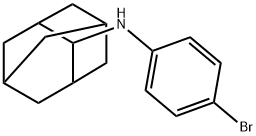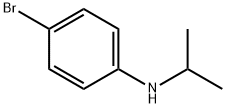Bromantane
- CAS NO.:87913-26-6
- Empirical Formula: C16H20BrN
- Molecular Weight: 306.24
- MDL number: MFCD02101627
- EINECS: 207-332-1
- SAFETY DATA SHEET (SDS)
- Update Date: 2023-12-18 17:09:30

What is Bromantane?
Description
Bromantane is an adamantine derivate that has a bromaniline side chain. It has been used therapeutically in Russia as a psychostimulant and anxiolytic. It have serotonergic, dopaminergic and limited noradrenergic actions,similar tomesocarb. Bromantane was first detected in 1996(Ayotte and Goudreault 1999), but due to juridical problems nine doping cases at the Atlanta Olympic Games were classified without consequences for the athletes. It was included in the IOC list of prohibited substances in September 1996,shortly after the Olympic Games.
The Uses of Bromantane
N-(2-ADAMANTYL)-N-(4-BROMOPHENYL)AMINE is an adamantane derivative used as an anxiolytic agent.
The Uses of Bromantane
Bromantane is a protectant, a substance that makes the body more stable under physical stress without increasing oxygen consumption. It has stimulant, anxiolytic and antifrail effects. It is able to increase endurance and work capacity under stressful and intense conditions.
Mechanism of action
The mechanism of bromantane action is based on the facility to increase the activity of the lower centers of the central nervous system (the hypothalamus nuclei, the reticular nuclei of the operculum, the hippocampus). It does not exert any expressed action on noradrenergic mediators, but implements the activation properties through the dopaminergic system. Bromantane strengthens GABA-ergic mediation, reducing gene expression, supervising synthesis of GABA-transporters, and functioning as a return capture mediator. A potentiality for central serotonin holding effects is also assumed.
Side Effects
Bromantane is said to have no addictive potential, and research done thus far shows that it doesn’t have serious side effects. Some users have reported having experienced brain fog, depression, and fatigue after the use of Bromantane. Nonetheless, there hasn't been sufficient research on Bromantane. Most of the trials have been conducted on rodents; therefore, its safety in humans is still uncertain.
Metabolism
Bromantane, upon oral induction, is quickly but not fully absorbed from the gastrointestinal tract into the blood (bioavailability: 42%). It is quickly, and in large quantities, distributed over the tissues and organs, and is slowly eliminated from the body. Bromantane is highly lipophilic, is distributed into the lipids of brain and fat tissue and, finally, is deposited in adipose tissue. The speed of bromantane absorption from the gastrointestinal tract is much higher in women, so the half-life is respectively lower than in men. The time to achievement of the maximum concentration of blood bromantane is 2.75 hours in women, and 4.0 hours in men. The drug is metabolized in the liver, but its elimination occurs mostly through the adrenal gland. Bromantane metabolism is characterized mainly by hydroxylation in the 6th position of the adamantan cycle. All of the determined metabolites can be found in urine, even in two weeks after administration of bromantane (this last fact is important for doping control).
Properties of Bromantane
| Melting point: | 106-108°C |
| Boiling point: | 404.8±28.0 °C(Predicted) |
| Density | 1.388±0.06 g/cm3 (20 ºC 760 Torr) |
| storage temp. | Refrigerator |
| solubility | Chloroform (Slightly), Ethyl Acetate (Slightly) |
| pka | 3.97±0.20(Predicted) |
| form | Solid |
| color | White to Off-White |
| InChI | InChI=1S/C16H20BrN/c17-14-1-3-15(4-2-14)18-16-12-6-10-5-11(8-12)9-13(16)7-10/h1-4,10-13,16,18H,5-9H2 |
Safety information for Bromantane
Computed Descriptors for Bromantane
| InChIKey | LWJALJDRFBXHKX-UHFFFAOYSA-N |
| SMILES | C12CC3CC(CC(C3)C1NC1=CC=C(Br)C=C1)C2 |
New Products
4-AMINO-TETRAHYDRO-PYRAN-4-CARBOXYLIC ACID HCL 4-(Dimethylamino)tetrahydro-2H-pyran-4-carbonitrile 4-Aminotetrahydropyran-4-carbonitrile Hydrochloride (R)-3-Aminobutanenitrile Hydrochloride 3-((Dimethylamino)methyl)-5-methylhexan-2-one oxalate 1,4-Dioxa-8-azaspiro[4.5]decane 5-Bromo-2-nitropyridine Nimesulide BP Aceclofenac IP/BP/EP Diclofenac Sodium IP/BP/EP/USP Mefenamic Acid IP/BP/EP/USP Ornidazole IP Diclofenac Potassium THOMAIND PAPER PH 2.0 TO 4.5 1 BOX BUFFER CAPSULE PH 9.2 - 10 CAP SODIUM CHLORIDE 0.1N CVS ALLOXAN MONOHYDRATE 98% PLATINUM 0.5% ON 3 MM ALUMINA PELLETS (TYPE 73) LITHIUM AAS SOLUTION 2-Bromo-1-(bromomethyl)-3-chloro-5-nitrobenzene 2-Bromo-3-nitroaniline N-(3-Hydroxypropyl)-N-methylacetamide 3-Bromo-6-chloropyridazine 4-ethyl-3-nitrobenzoic acidRelated products of tetrahydrofuran
You may like
-
 N-(2-Adamantyl)-N-(4-bromophenyl)amine CAS 87913-26-6View Details
N-(2-Adamantyl)-N-(4-bromophenyl)amine CAS 87913-26-6View Details
87913-26-6 -
 1-Methyl-6-oxo-1,6-dihydropyridazine-3-carbonitrile 98%View Details
1-Methyl-6-oxo-1,6-dihydropyridazine-3-carbonitrile 98%View Details
99903-60-3 -
 1823368-42-8 98%View Details
1823368-42-8 98%View Details
1823368-42-8 -
 2-(3-(tert-butyl)phenoxy)-2-methylpropanoic acid 1307449-08-6 98%View Details
2-(3-(tert-butyl)phenoxy)-2-methylpropanoic acid 1307449-08-6 98%View Details
1307449-08-6 -
 Ethyl 3-(furan-2-yl)-3-hydroxypropanoate 25408-95-1 98%View Details
Ethyl 3-(furan-2-yl)-3-hydroxypropanoate 25408-95-1 98%View Details
25408-95-1 -
 2-Chloro-5-fluoro-1-methoxy-3-methylbenzene 98%View Details
2-Chloro-5-fluoro-1-methoxy-3-methylbenzene 98%View Details
1805639-70-6 -
 1784294-80-9 98%View Details
1784294-80-9 98%View Details
1784294-80-9 -
 Lithium ClavulanateView Details
Lithium ClavulanateView Details
61177-44-4
